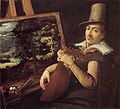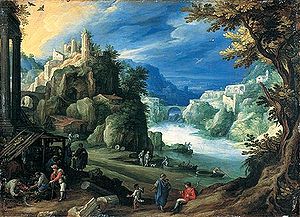
Paul and Mattheus Brill
Encyclopedia

Landscape art
Landscape art is a term that covers the depiction of natural scenery such as mountains, valleys, trees, rivers, and forests, and especially art where the main subject is a wide view, with its elements arranged into a coherent composition. In other works landscape backgrounds for figures can still...
painters who worked in Rome after earning papal
Pope
The Pope is the Bishop of Rome, a position that makes him the leader of the worldwide Catholic Church . In the Catholic Church, the Pope is regarded as the successor of Saint Peter, the Apostle...
favor.
Biography

Capriccio (painting)
In painting, a capriccio , means especially an architectural fantasy, placing together buildings, archaeological remains and other architectural elements in fictional and often fantastical combinations, perhaps with staffage of figures. It fits under the more general term of landscape painting...
(whims or fancies) or vedute ideate or veduta
Veduta
A veduta is a highly detailed, usually large-scale painting of a cityscape or some other vista....
di fantasia, with typical rustic hills with a few ruins. Matthijs began work on several fresco
Fresco
Fresco is any of several related mural painting types, executed on plaster on walls or ceilings. The word fresco comes from the Greek word affresca which derives from the Latin word for "fresh". Frescoes first developed in the ancient world and continued to be popular through the Renaissance...
es in Rome from 1570 onwards, and his work includes the Vatican's
Vatican City
Vatican City , or Vatican City State, in Italian officially Stato della Città del Vaticano , which translates literally as State of the City of the Vatican, is a landlocked sovereign city-state whose territory consists of a walled enclave within the city of Rome, Italy. It has an area of...
Seasons and the floor to ceiling frescos in the Torre dei Venti. Matthijs died in 1583, and his brother continued his work, picking up many of Matthijs' commissions. Paul, a student of Damiaen Oertelmans, painted frescoes such as the landscapes in the Casino Rospigliosi (Rome), and The Roman Forum, which showed this site for what it had become: a slum
Slum
A slum, as defined by United Nations agency UN-HABITAT, is a run-down area of a city characterized by substandard housing and squalor and lacking in tenure security. According to the United Nations, the percentage of urban dwellers living in slums decreased from 47 percent to 37 percent in the...
for squatters and pasture
Pasture
Pasture is land used for grazing. Pasture lands in the narrow sense are enclosed tracts of farmland, grazed by domesticated livestock, such as horses, cattle, sheep or swine. The vegetation of tended pasture, forage, consists mainly of grasses, with an interspersion of legumes and other forbs...
for livestock
Livestock
Livestock refers to one or more domesticated animals raised in an agricultural setting to produce commodities such as food, fiber and labor. The term "livestock" as used in this article does not include poultry or farmed fish; however the inclusion of these, especially poultry, within the meaning...
(so much so that the place was nicknamed Campo Vaccino, or "The Cowfield"). His masterpiece may be a fresco in the Clementine Hall
Clementine Hall
The Clementine Hall is a hall of the Apostolic Palace near St. Peter's Basilica in Vatican City. It was established in the 16th century by Pope Clement VIII in honor of Pope Clement I, the third successor of St. Peter. The Clementine Hall is covered in Renaissance frescoes and valuable works of art...
of the Vatican, a monumental depiction of The Martyrdom of St. Clement.
Paul also did small cabinet painting
Cabinet painting
A cabinet painting is a small painting, typically no larger than about two feet in either dimension, but often much smaller. The term is especially used of paintings that show full-length figures at a small scale, as opposed to say a head painted nearly life-size, and that are painted very...
s on copper
Copper
Copper is a chemical element with the symbol Cu and atomic number 29. It is a ductile metal with very high thermal and electrical conductivity. Pure copper is soft and malleable; an exposed surface has a reddish-orange tarnish...
, some of which are signed with a pair of glasses
Glasses
Glasses, also known as eyeglasses , spectacles or simply specs , are frames bearing lenses worn in front of the eyes. They are normally used for vision correction or eye protection. Safety glasses are a kind of eye protection against flying debris or against visible and near visible light or...
(a pun on the Flemish word 'bril' which means 'glasses'). A prolific draftsman, his drawings were popular with collectors and were copied by the many students who worked with him in his studio, which was a popular destination for Netherlandish artists visiting Rome. He often collaborated on paintings with Johann Rottenhammer, who according to a dealer's letter of 1617 painted the figures in Venice and then sent the plates to Rome for Bril to complete the landscape. He also collaborated with his friends Jan Brueghel the Elder and Adam Elsheimer
Adam Elsheimer
Adam Elsheimer was a German artist working in Rome who died at only thirty-two, but was very influential in the early 17th century. His relatively few paintings were small scale, nearly all painted on copper plates, of the type often known as cabinet paintings. They include a variety of light...
, whom he both influenced and was influenced by. His collaboration with Elsheimer is shown in a painting now in Chatsworth House
Chatsworth House
Chatsworth House is a stately home in North Derbyshire, England, northeast of Bakewell and west of Chesterfield . It is the seat of the Duke of Devonshire, and has been home to his family, the Cavendish family, since Bess of Hardwick settled at Chatsworth in 1549.Standing on the east bank of the...
.
Agostino Tassi
Agostino Tassi
Agostino Tassi was an Italian painter, mostly of landscapes and seascapes, who is now best known as the rapist of Artemisia Gentileschi....
may have been Paul's pupil. Tassi later became the master of Claude Lorrain
Claude Lorrain
Claude Lorrain, , traditionally just Claude in English Claude Lorrain, , traditionally just Claude in English (also Claude Gellée, his real name, or in French Claude Gellée, , dit le Lorrain) Claude Lorrain, , traditionally just Claude in English (also Claude Gellée, his real name, or in French...
. The Bril Brothers form one of the links between the panoramic
Panorama
A panorama is any wide-angle view or representation of a physical space, whether in painting, drawing, photography, film/video, or a three-dimensional model....
views of Joachim Patenier and the ideal landscape evolved by Nicolas Poussin
Nicolas Poussin
Nicolas Poussin was a French painter in the classical style. His work predominantly features clarity, logic, and order, and favors line over color. His work serves as an alternative to the dominant Baroque style of the 17th century...
and Claude Lorrain. In 1621, Bril became head of the Accademia di San Luca, the artists' academy in Rome.
Sources
- Peter and Linda Murray, The Penguin Dictionary of Art and Artists. Fifth Edition: Revised and Enlarged (Penguin Books, London, 1988), 51.
- Carla Hendriks, Northern Landscapes on Roman Walls: The Frescoes of Matthijs and Paul Bril. (Florence : Centro Di della Edifimi, c2003).
- Rudolf Baer, Paul Bril: Studien zur entwicklungsgeschichte der Landschaftsmalerei um 1600. (Munich: J.B. Grassi, 1930).
- Francesca Cappelletti, Paul Bril e la pittura di paesaggio a Roma, 1580-1630. (Rome: Ugo Bozzi, c.2006).
- Louisa Wood Ruby, Paul Bril: The Drawings. (Turnhout: Brepols, 1999).
- Anton Mayer, Das Leben und die Werke der Brueder Matthaeus und Paul Brill. (Leipzig: K.W. Hiersemann, 1910).

